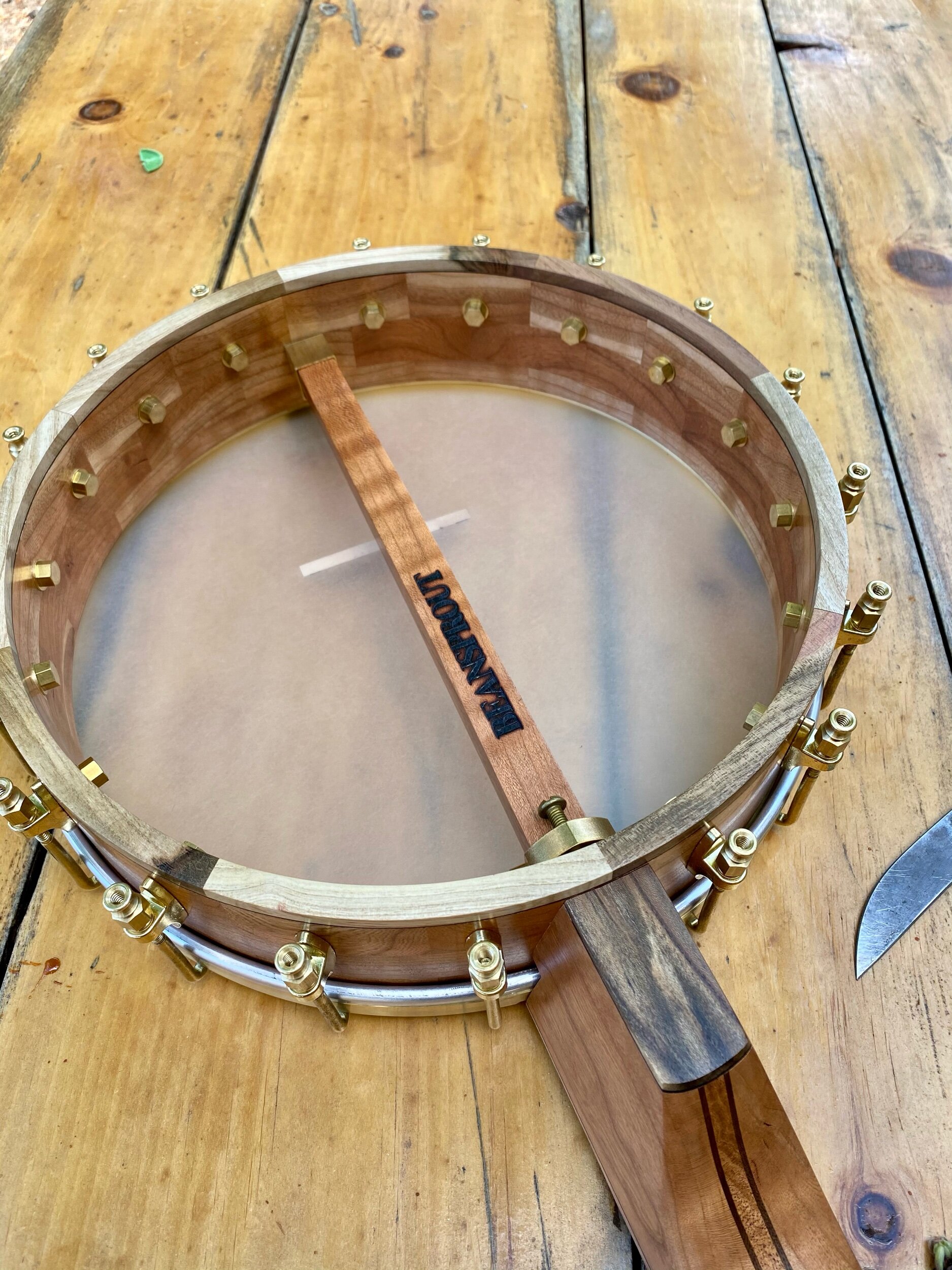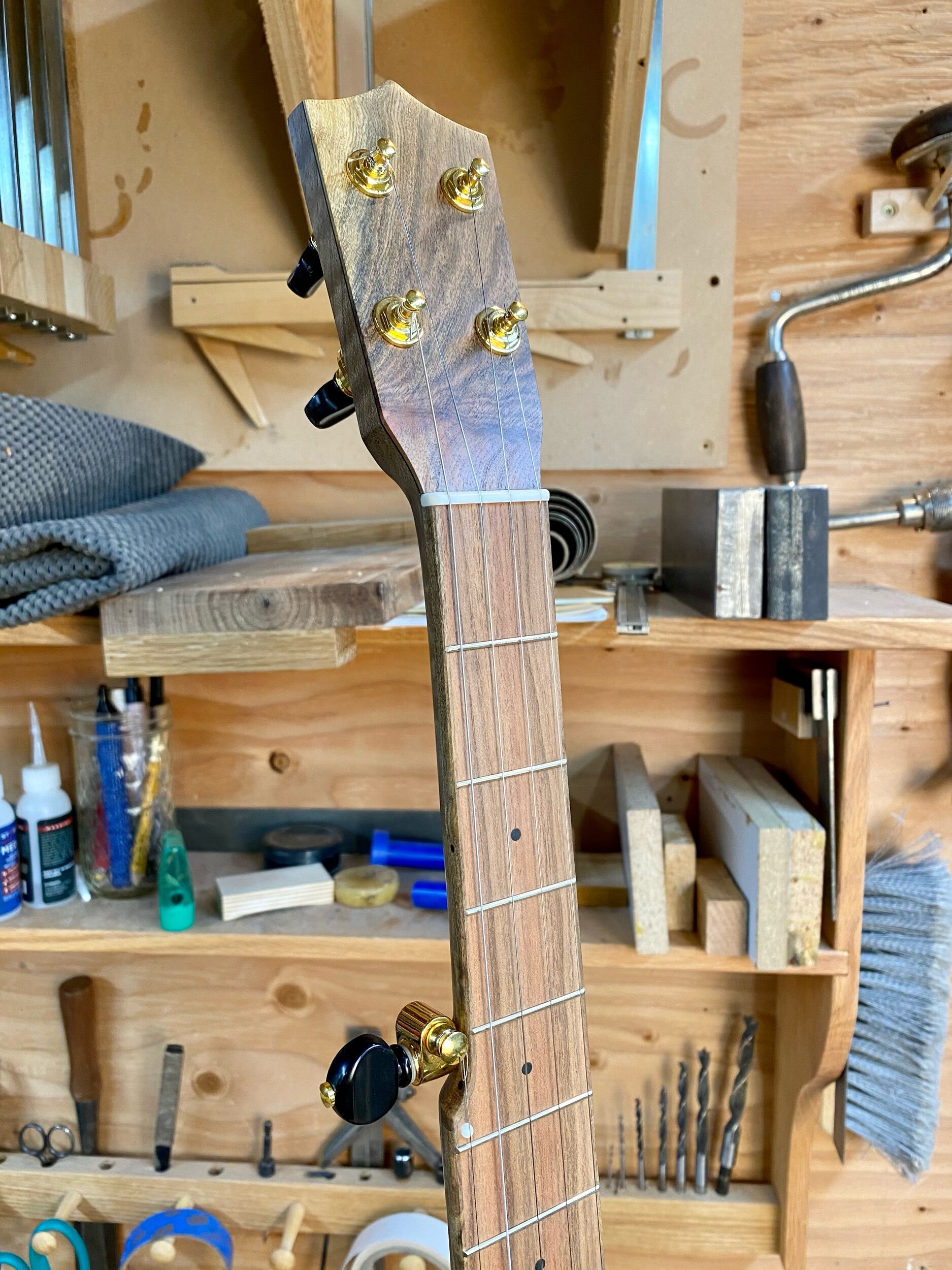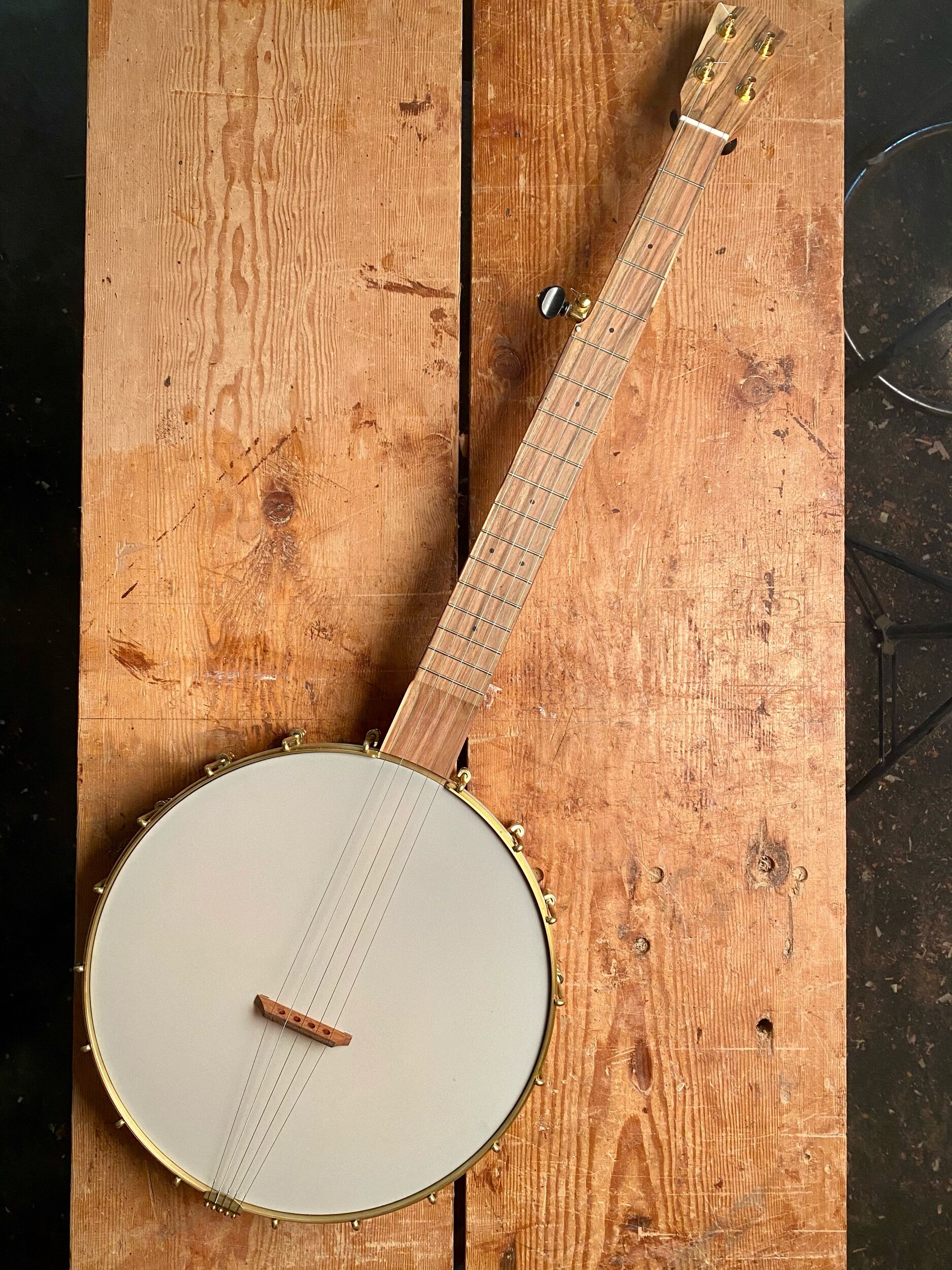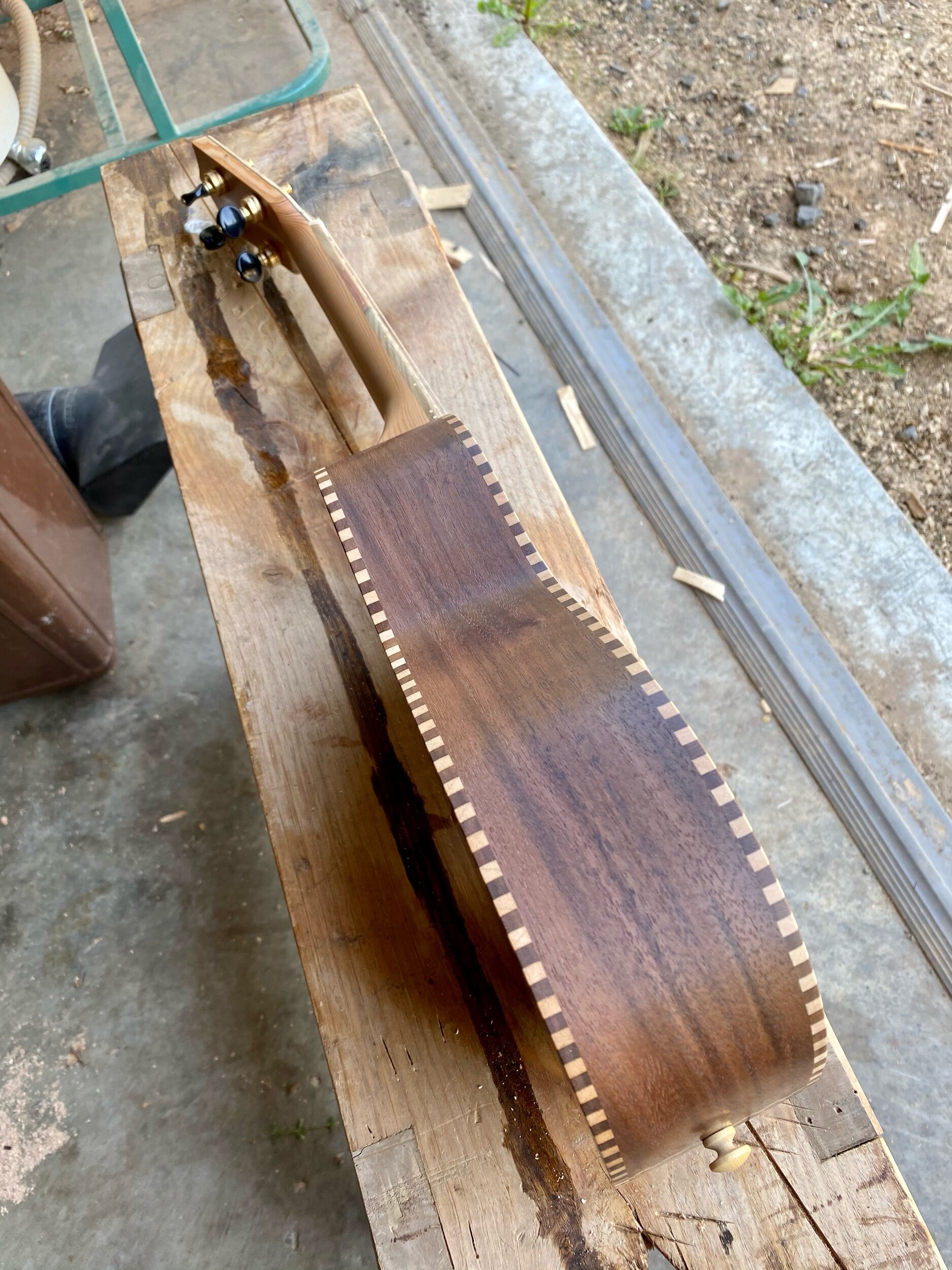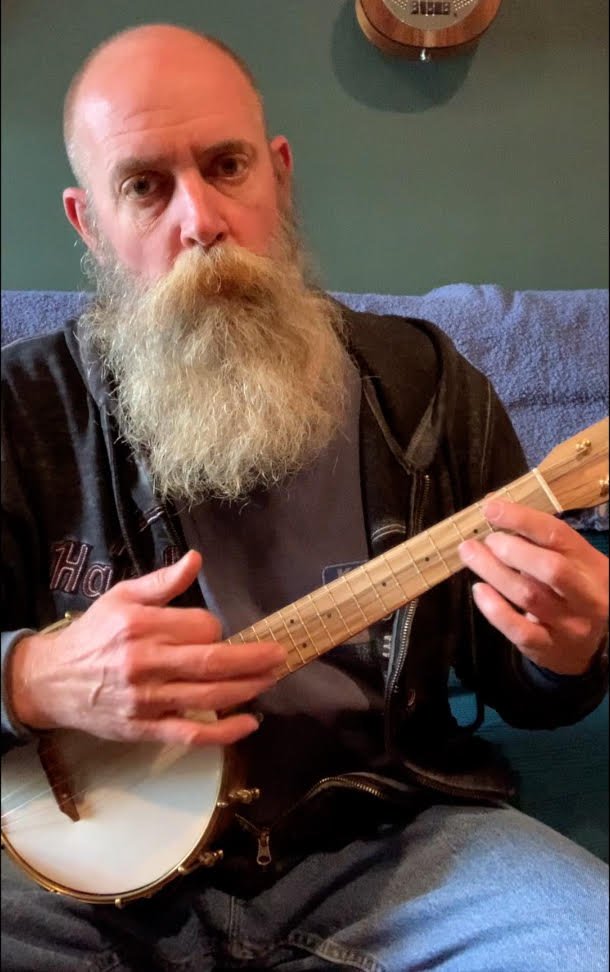This is another instrument for a patron who has several instruments of mine. As time as passed, her needs have changed and she requested a few small changes to meet them. First up, she needed larger side and front dots with high contrast to the fretboard wood. We picked white shell in dark brown Texas Ebony. She also needed a flat fretboard, low action and a thin neck, similar to a nice Martin that she has. Both the Cedar top and Mahogany back and sides were salvaged from the Rebuild-It center in Hood River. The Texas Ebony fretboard and Spanish Cedar neck are from a retired banjo builder. The maple binding adds a nice contrast and the nickel tuners and strap buttons match nicely.
#597- Myrtle Baritone Ukulele
For several years I played an all Myrtle baritone as my personal instrument. The light weight, balanced tone and earth tone colors feel quite familiar. This one does not disappoint, with a simple pistachio fretboard and cedar neck, it remains understated but ready to speak up! The Pistachio is from California orchards and the Myrtle is from the Oregon coast, both from woodfromthewest.com. The Western Red Cedar neck was rescued from a barn in Hood River, OR.
“ ...I’ve been playing it a couple of hours each day. The sound is incredible and the sustained voicing is warm and soft. I just love it. And of course, the workmanship. I couldn’t be happier!
Thanks again for such a beautiful uke.
Regards,
J.S.H.”
#600- Redwood and Curly Walnut Tenor Ukulele
I’m not sure I believe in coincidences, but I do think things rhyme once in a while. In this case, #600 turned out to be almost the same specs as #500. When Anne picked out her specs, she didn’t know what her number would be and I don’t think about it until I start the instrument and assign the next number in the database. This combo of redwood and walnut is always a winner, it sounds like dark chocolate with a citrus edge. The curly walnut back and sides is from guitar maker Ben Bonham, cut on the Washington side of the Columbia River. The redwood is from guitar maker Jayson Bowerman from Bend, OR. Both of these generous makers save me ukulele size pieces from their guitar builds. The fretboard, headplate and bridge is from California Orchards. The salvaged fir neck is from a Portland floor joist.
“Wow! My new ukulele is so perfect, it brought tears to my eyes. It looks and sounds so beautiful and is a joy to play. The finish is so smooth and I love how all the parts compliment each other. A work of art. And Nicole, the inscription inside is exquisite, thank you so much.
I think it’s cool how the numbers worked out too. I’m happy to think of #500 in the UK. My mother lived in London for many years and it’s one of my favorite places.
Thanks again for the work you do and the music and the beautiful instruments you make.
- A. F. ”
#598- Curly Port Orford Cedar and Cherry Tenor Ukulele
I have made many tenor ukuleles. During my time at Mya-Moe, something like 75% of what we built were tenors. Since then, it’s probably closer to 50%, but you get the idea. You would think with all that experience, that I can’t be surprised and delighted anymore, but you would be wrong. This one grabbed me. Sweet and cheerful, but also substantial and rich. Maybe like good BBQ? I don’t know, words and metaphors don’t really help, just listen to it. The curly POC from the Oregon coast and the pistachio from California orchards is courtesy of woodfromthewest.com. The cherry back and sides and fir neck are salvaged from the Carpenter Ant stash in Portland.
“My ukulele got here yesterday, and I stayed up way too late playing it.
You know, when a child gets overwhelmed by emotion, adults tell them to use their words. But I am overwhelmed by emotion, and it’s taken my words too. This ukulele is so beautiful. And sounds so amazing. Here are are few words to try and describe my feelings. But understand that they are an inadequate description.
First, the wood. The sum is so much greater than the parts. The curly Port Orford Cedar is magnificent. And I know the wood will only get richer looking over time. The pistachio fretboard blends so well with it. I like the feel of pistachio. But didn’t want too much color, and this fretboard is perfect. The cherry back and sides are detailed and have character. Just what I wanted. The Douglas fir just brings home that this ukulele is made from Northwest wood.
It’s hard to describe the sound. It’s bright, but at the same time it has depth. How does that happen? And it has a sustain that is wonderful to hear on fingerpicking and campanella. At the same time, the strumming is clear and resonant. I’m just starting to explore what it can do.
I anticipated getting a great ukulele that would be fun to play. I didn’t expect anything this wonderful in look and sound. Enough words. I have to go play my ukulele.
Thank you for this wonderful instrument.
- S. S.”
#595- Spruce and Myrtle Scout Ukulele
Another Scout ukulele, salvaged from my own shop scraps. This one doubles down on the Wabi-Sabi aesthetic: muted earth tones, featured imperfections and rustic textures. Spruce top, Myrtle back and sides, white Oak fretboard, Hemlock and Walnut neck and Pistachio everything else.
“Hi Guys,
What a beautiful/cute instrument this is! I love looking at her and I get a real chuckle out of her fun- loving voice. I hear a little banjo in there. Your way with wood is truly masterful. Thanks for another wonderful instrument.
- D. C.”
#596- Walnut and Pistachio Tenor Banjo Ukulele
I used to overly praise loud instruments. But, now I’m more focused on a wide dynamic range. I like a banjo that is sweet, rich and loud. This one has it. The Oregon walnut is from Goby in Portland and the pistachio is from California orchards. I darkened the brass hardware from Brooks Masten, which is always classy. Some extra big fretboard dots were added for increased visibility.
“Aaron and Nicole,
I finally received my tenor banjo uke last Friday. It is all I expected and hoped for. A beautiful looking and sounding instrument. I find it a privilege to own such an instrument and I hope it remains in my family for generations. I love the wood coloring, the dark walnut and beautiful pistachio. The feel of the neck is amazing I have not held an instrument like it. I am used to playing a tenor uke so the sound is quite different but so fun. I find it plenty loud and as you said sweet and rich. Once again thank you, it truly is a treasure.
- K. A. ”
#589- Fir and Walnut Scout Ukulele
Humble and sweet and ready to party, this Scout is for our friend Rob on his 72nd birthday! The brass fret markers in the curly walnut fretboard and the maple trim veneers give it a unique look. The fir is from the Carpenter Ant stash and the walnut is from the cutoffs bin at Goby Walnut in Portland.
“Dear Aaron and Nicole,
I could give you a pro & con review of the Scout.... except that there are no cons! I spent about two hours playing it yesterday. The uke has a neat, loud, “punchy” sound. The brass fret markers are really nice looking, and the top just glows. But it’s the back that’s really stunning.
The back story is that if my wife has a “spirit animal” or a “totem”, it’s the owl. Her late Mom was fascinated by owls, and our house has a lot of owl-themed art and even jewelry. When I saw the early photos I thought, “Wow, one of her owls is speaking to me.” And then in the gallery video Aaron mentioned the owl-ish look.
The case for the uke is really nice. The Scout may be doing a lot of traveling with me.
Thanks again,
R. S. ”
#591- Curly Cherry and Pistachio Five String Banjo
This is the second banjo this month made from some wood I bought from a retired banjo builder. It is some very dense curly cherry and it looks and sounds awesome. I had a great time playing this banjo the last couple of days and I truly love the sound. The cherry is balanced with some multi colored, grafted pistachio from California orchards. The rim is an 11” block rim with a rolled brass tone ring, but I swear it’s louder than my maple tubaphone!
#590- Curly Walnut and Pistachio Five String Banjo
When I heard this banjo’s first notes, it felt very familiar to me. It is similar to my first banjo, made by OME when I still lived in Colorado. It has a 12” curly walnut block rim with a rolled brass tone ring and Renaissance head. I like this setup, as it has a nice depth and warmth, but some volume and grit from the brass ring. The curly Claro walnut is from California and the pistachio is as well, both via woodfromthewest.com.
“I absolutely adore my #590. Aaron, your craftsmanship and attention to detail are impeccable. I can see the care you took during the build, each time I open the case and can feel it every time I play. The playability is most noticeable and the action is just where I like it. I’m so glad you guided me to the brass tone ring with the walnut! It’s a good balance of grit with a balanced brightness. I am forever a customer of yours and plan to place more orders in the near future! Thank you for building me a banjo that brings such smiles to my family of five.
Best,
C. A. ”
#593- Myrtle Alto Ukulele
Whoa! Check out that weird Myrtle set! I’m glad the customer went for it. I doubled down on the natural weirdness of this Myrtle set by choosing a pistachio fretboard with a cool knot in it and a salvaged fir neck with a couple of nail holes. It is lightweight and easy to play, with a cheerful sound. The Myrtle is from the Carpenter Ant stash, the fir is salvaged from a floor joist and the pistachio is from California orchards.
“Hello Aaron, Nicole & Henry.
I have to tell you thank you so much for the wonderful ukulele!!! The sound is beautiful, and happy, and the intonation is excellent, all the way up the fretboard. This uke really sings! The fancy pattern on the myrtle adds such character and interest, and the pistachio fretboard is lovely. The maple binding is the perfect accent for the lively myrtle, and the nail hole on the fir neck makes me laugh. And yet again, as with the Tenor that you made for me, I’m amazed at the artistry & skill that is shown at every part of this instrument. I’m thrilled to be able to play such a wonderful uke! I’m also still loving Tenor #456, which you sent back in January 2020. These instruments have truly been a bright & uplifting spot in a difficult year. Sending much appreciation!!!!
- B. K. ”
#588- Builder’s Choice- Fir and Koa Tenor Ukulele
This ukulele has one of my favorite wood combinations: old growth Douglas fir top and Hawaiian Koa back and sides. It makes for a really nice sound that has a different flavor than an all Koa instrument. I decided to use this builder’s choice model to try out a couple of new woods I bought from a retired builder as well. First up is a Texas ebony fretboard and headplate. This is an un-common domestic wood that is related to the blacker ebony more commonly seen on guitars. It is a rich brown color and very hard and stiff, perfect for a fretboard. Next is Spanish cedar for the neck. This wood is from Central America and is a relative of mahogany. It was quite popular for guitars and ukuleles 100 years ago, but is hard to find nowadays. The fir is from a salvaged stair tread and the Koa is from the Carpenter Ant stash. All of this adds up to a unique instrument with some of my favorite woods and some new things as well. Easy playability, sweet tone and a classic aesthetic. Update: This instrument is SOLD:)
#592- Cherry and Pistachio Five String Banjo
Cherry has always been a favorite banjo wood for me. It’s plenty loud, but sweeter than maple. I have access to a lot of it, thanks to the Carpenter ant stash and it’s easy to work. This one has a curly cherry 12” rim with Texas ebony tone ring and synthetic head. I recently bought a stash of wood from a retired banjo builder, so you will see more of this Texas ebony and curly cherry coming up. The pistachio is from California orchards, wrapping up a banjo made of all domestic woods. It is a pleasure to play, humming and singing all over the fretboard!
“Aaron, Nicole & Henry,
You have exceeded all my expectations and hit it out of the park! I see this banjo getting a lot of play time this summer.
Thank you!”
#594- Port Orford Cedar and Walnut Alto Ukulele
Even though this one has some of my most popular woods, the customer’s small requests made for a unique and special instrument. I’ve had a great time playing it the last couple of days too, easy action, a sweet tone and plenty of volume. The old growth Port Orford cedar top from the Oregon coast is stained with natural blue mineral stains or spalting. I love its subtle texture and look. The striped Oregon walnut back and sides is from the shorts bin at Goby in Portland. The pistachio has a really unique look, from California orchards. Lastly, the old growth for neck was salvaged from a floor joist. The brass fret dots and rope binding add some nice detail to complete the look.
“To Aaron, Nicole and the Inestimable Henry,
Heartfelt gratitude, belated and ongoing, for my beautiful Alto- #594. A few months into Life-ing with this ukulele, I am more thrilled than ever: your outlook, artistry and skill have resulted in an instrument that is bringing me joy on so many different levels.
I love all the stories in the wood, and look forward to all the new stories yet to be told: reclamation, grace, and some good ol’ punch. For the work of your hearts and your hands, and for #594: Thank you!
My best to you and yours,
- S. S. ”
#578- Builder’s Choice- Douglas Fir Firewood Baritone Ukulele
This project started last fall when I bought a pallet of firewood off Craigslist. It was mostly scraps from a farm sawmill and I decided to keep a few for projects. I stacked them in the shop to dry out for a few months before starting on a uke. As you know, I regularly use fir for ukes, but it’s mainly old growth salvaged wood, which has a fine grain to it and is very strong and light. This second growth wood is a little heavier and wider grained. I thought it would be a fun experiment. After all, if I don’t like it I can just burn it! I used walnut for binding and neck stripe and maple for fretboard, headplate and bridge. The fretboard is also an experiment for me, as it was stabilized with resin to make it harder and stiffer, which I think is a good move. I got it from woodfromthewest.com.
I like the sound a feel of this uke a lot. The whole thing hums and vibrates with a mid range intensity that I like. Sort of like a flamenco guitar vs a concert grade classical guitar. I plan on keeping this for myself, unless one of you swoops in. After all, I’ve got more firewood!
See below for an extra gallery of in process photos.
#584- Spruce and Grafted Walnut Baritone Ukulele
Spruce and walnut baritones have become pretty popular around here lately, and it’s easy to see/hear why. This one is plenty loud but has a rich and smooth tone as well. The Engelmann spruce top is from a retired guitar builder. The grafted walnut back and sides and the grafted pistachio fretboard and headplate come from California orchards. The fir neck is salvaged from a floor joist.
#587- Redwood and Curly Myrtle Scout Ukulele
Today I offer you another member of the Scout ukulele family: rustic, handmade and one of a kind. This one has a redwood top that I got from Jayson Bowerman, a luthier from Bend, OR. The Myrtle back and sides and the mahogany neck are made from scraps from other ukuleles. The fretboard, headplate and bridge are Jatoba or Brazilian cherry, a very dense hardwood that I salvaged from the Carpenter Ant stash in Portland. This one has a really nice tone, due to the redwood top, I imagine.
““I am so happy I asked to be added to the Scout waiting list! I was hesitant since I knew I would have no choice in the woods used to make the ukulele, but I decided there was little risk after I viewed the completed Scout ukes in the gallery and saw they were all beautiful and sounded fantastic. I own other Beansprouts and have always enjoyed following the progress of my instrument build on social media and was afraid I would miss out on that with a Scout. However it turns out the Scout experience is exciting in its own way! It was fun to see the photos of Scout builds in progress posted to social media and to watch the completed work demo videos and to wonder if that was going to be MY Scout. When I saw the video for this one, I was blown away by how awesome it was and simultaneously disappointed it wasn’t mine since I had not been contacted about it. However, a few hours later I was elated when I received an email from Nicole offering that very Scout uke to me! I had not set my heart on any particular wood combination, but I could not have chosen a better combination if I tried. This is the perfect Scout for me! Aaron often speaks about the concepts of wabi sabi and acceptance and how they are guiding principles in his work. I feel like the process of getting a Scout uke exemplifies these principles and of the Beansprout brand overall. Of course there are no flaws in this ukulele to accept, so I mean that from the perspective of accepting that I did not choose the woods or the build date. By placing my trust entirely in Aaron’s artistic eye and skillful hands and allowing fate to flow I ended up with my dream Scout uke. This ukulele and the experience of getting it is a good reminder to me that sometimes it is best to get out of my own way and see what beautiful things come to me as a result. Thank you for the fantastic ukulele! I always feel so lucky to receive a Beansprout instrument and to feel like I have a tiny part in the Beansprout family.”
- J. L. ”
#585- Port Orford Cedar and Myrtle Alto Ukulele
This instrument was ordered by a customer who already has several nice ukes, including some traditional Koa ukuleles made by Hawaiian makers. He said he wanted something different and he got it! The rich earth tones, asymmetrical figure and small wabi-sabi surprises certainly make it unique. The port orford cedar is from the Oregon coast and the pistachio is from California orchards, via woodfromthewest.com. The myrtle is from the same board as Nicole’s ukulele, discovered by us at a roadside stand in Manzanita. The fir is from a salvaged floor joist. It really has a sweet voice that only needs a gentle touch to speak out. I’m quite pleased with it.
“Beansprout 585 is beautifully built. I’m tempted to hang it on the wall as a piece of folk art (not to worry Aaron, I keep it in the case!). I do not regret taking the “plunge” into a little wabi-sabi. The one-piece, asymmetric wood was a “first” for me, and it looks great. Aaron’s choice of a walnut bridge and binding was excellent and ties everything together. It definitely looks different from my other ukes! Aaron mentioned in his video that the uke has an “earth tone vibe” and I agree. For me, it is classic Pacific Northwest. It looks like an instrument with an old soul and stories to tell. It’s very cool to know there is not another one like it in the whole world.
The sound of the instrument is definitely different from my traditional ukuleles, which is what I wanted. At first, it was hard for my ear to “place” the sound - definitely ukulele, but also “dirtier” or “smoky”... with some guitar thrown in. The tone of the uke has “opened up” with time, too. It is a unique voice in my ukulele collection. Intonation is great all the way up the neck. I find the instrument especially sings when I am picking, which makes me wish I was a better picker (on my “to do” list!).
Thanks again for checking in with me and for making such a beautiful instrument.
Best wishes,
- F. Q. ”
#586- Figured Walnut and Pistachio Tenor Banjo Ukulele
It still amazes me after all this time that each instrument comes out looking, sounding and feeling unique. They really all do have their own personalities, which really keeps it fun for me. The combination of walnut, goat skin and a low fourth string really makes this one rich and dark but plenty loud. Really fun to play. The walnut is from Edensaw in Port Townsend, WA and the pistachio is from California Orchards.
“I really love the instrument - the setup is so nice I’m able to play some of the more challenging (for me) chords successfully. I like the sound variations you can get - playing over the head has a very banjo sound, but playing over the fretboard reduces that quite a bit. It also looks great - the walnut is beautiful and I really like the pistachio as well - the contrast between the two is really nice. I also really like the way the discoloration in the goat skin worked out as it lends an “antique” sort of look to the instrument.
-E. S. ”
#581- Curly Port Orford Cedar and Curly Myrtle Baritone Ukulele
When Ian selected the wood for this instrument, I was struck by the muted color pallet and earth tone vibe. Without any binding or purfling, it really shows off the wood grain. I doubled down on this look by using walnut veneers instead of black and by darkening the brass hardware. The flash of rope binding on the fretboard is all it needs. All the wood, except for the salvaged fir neck, is from woodfromthewest.com.
#580- Port Orford Cedar and Quilted Maple Alto Ukulele
This one is all about balance: the robust Port Orford cedar balanced by brilliant maple, the asymmetrical top and back balanced by straight grain hemlock and pistachio and the light colored woods wrapped in dark walnut binding. Also, the best bug hole ever was revealed in the hemlock neck when I sawed into it. I love it so much, I had to feature it. The maple and hemlock are from the Carpenter Ant stash in Portland and the Port Orford cedar and pistachio are from woodfromthewest.com.
“Hi Aaron & Nicole,
Thanks for checking in. The Alto, for me, is really in that Goldilocks zone of being just right for every situation. It is light, easy to play and is LOUD. It sounds great strummed or finger picked. Maybe its recency bias, but I think its my favorite of the three Beansprout Ukes I have so far!
Looking forward to seeing what you cook up with the
5-string Banjo this fall!
- J. P. ”

















































